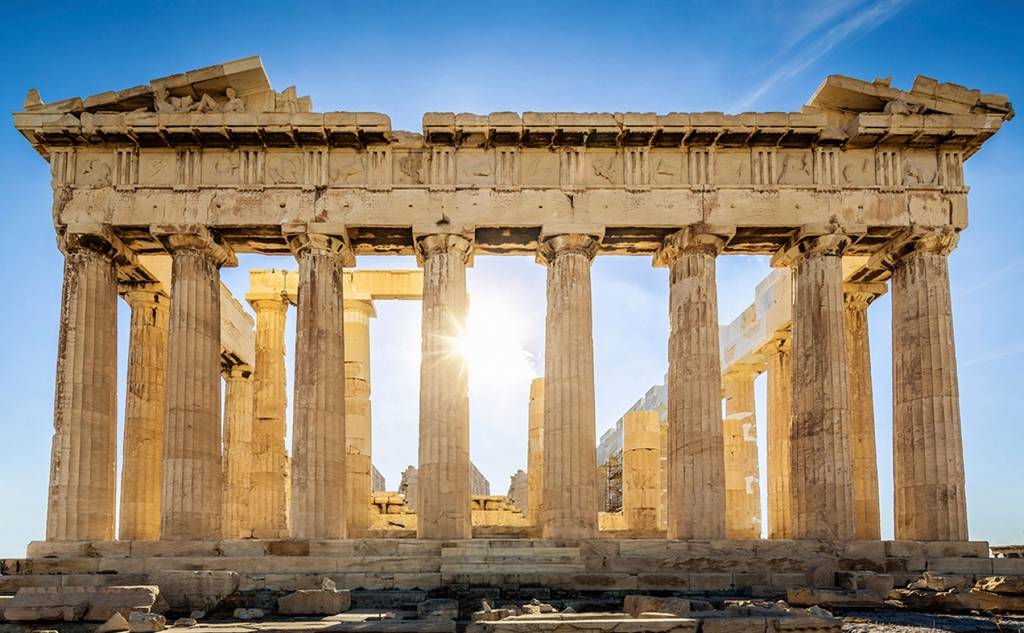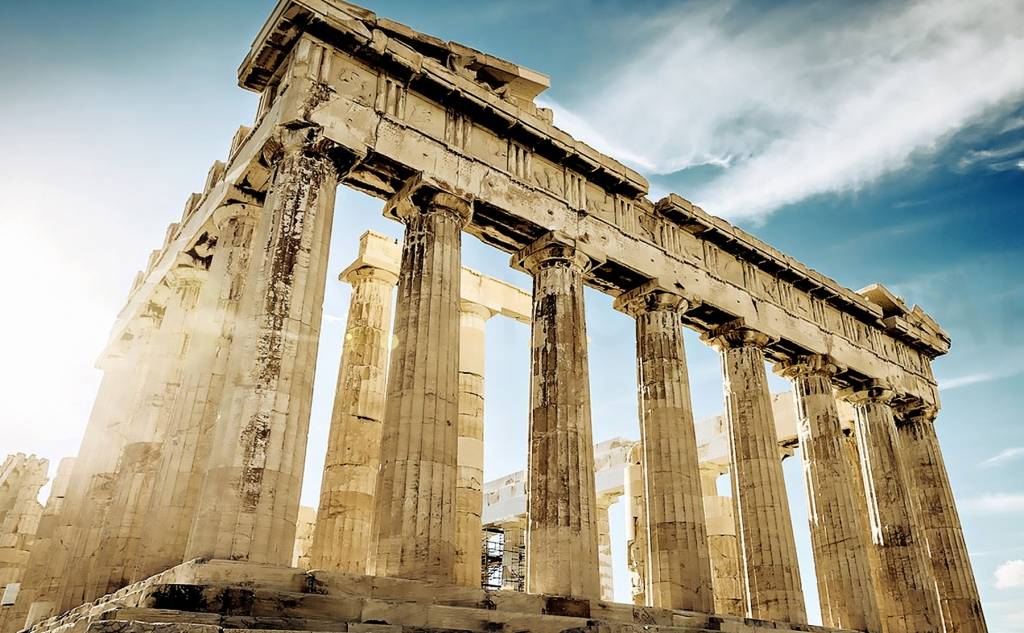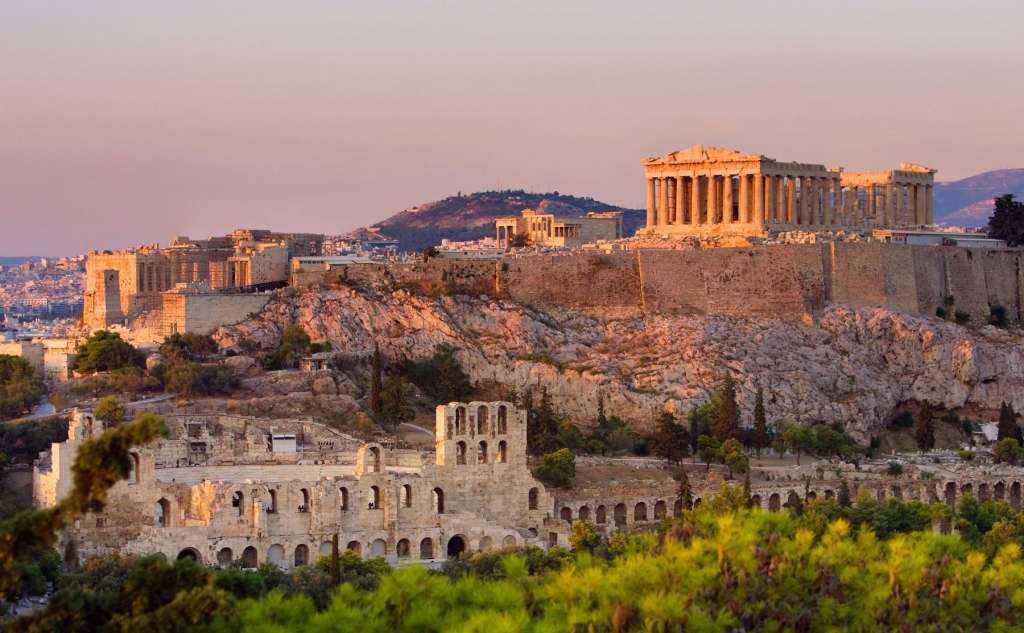The Parthenon
The Parthenon is the first and most important monument on the Sacred Rock of the Acropolis of classical times, a building remarkable for its proportions and masterful construction. The hill of the Acropolis is naturally a fortress inaccessible from all sides except the west. The rock was protected by walls as early as the Mycenaean era, and traces of this fortification are visible, mainly in the southeast of the Propylae.
The UNESCO World Heritage Site is dedicated to the patroness of the Athenian city, Athena Parthenos. It was built in 447-438 BC as part of the broader building programme initiated by Pericles. For the construction of the Parthenon, the architects Iktinos and Kallikratis collaborated, while sculptor Phidias was responsible for the sculptural decoration, as well as the general supervision of the work. Characteristically, he was referred to as "general supervisor" by historian Plutarch. The first source in which the entire building is characterised as the Parthenon is a text by rhetor Demosthenes (4th century BC), while in documents from the 5th BC century was referred to as the "temple".
It is a pavilion double Doric temple (with many Ionic elements) made of Pentelic marble (except for the stylobate, which was made of limestone) with a six-pillar amphiprostyle nave, measuring approximately 70 metres long, 31 metres wide and 15 metres high. The building consisted of roughly 16,500 marble architectural members. The church roof was pitched, wooden and covered with marble tiles. The perimeter wings, the front vestibule and the one in the back had marble ceilings of large horizontal roofs with panels, square recesses with perimeter waves and painted decorations in the centre. The Parthenon was famous for its so-called refinements, deviations from geometric forms or curves, thanks to which the building looked like a living organism with internal breathing.
The giant gilt-ivory statue of Athena Parthenos, the work of sculptor Phidias (about 13 metres high), which dominated the temple’s interior, was considered a masterpiece. We only have an idea of the statue’s shape from small Roman copies. The goddess, standing, wore a long veil and an aegis (a device carried by Athena - and Zeus, variously interpreted as an animal skin or a shield) with a representation of Medusa's head. Meanwhile, her head was adorned with an elaborate headdress richly decorated with mythological animals. She held a statue of the goddess Nike in her right hand and, with her left, her shield resting on the ground. On the outside, the shiel had a relief representation of an Amazon battle, and on the inside, a painted representation of a Giants battle. Also, embossed scenes of the Centaur battle could be seen on the edges of her sandals. Finally, there was a relief representation of Pandora’s birth on the statue's pedestal.
The pediments of the Parthenon are decorated with sculptural compositions inspired by the life of the goddess Athena. In the east, the birth of Athena from the head of her father, Zeus, in the presence of all the gods of Olympus is depicted, and in the west, the dispute between Athena and Poseidon for the guardianship of the city of Athens. The 92 metopes were the first parts of the temple to be decorated with mythological relief representations by great sculptors of the time (445-440 BC) and are placed above the portico of the outer colonnade of the temple and below the cornice. On the east side, the Battle of the Giants is depicted. On the west side is the Battle of the Amazons, on the south is the Battle of the Centaurs, and finally, on the north side, there are scenes from the Trojan War.
The frieze surrounded the upper part of the nave and the front parts of the temple, and the theme of its decoration was the majestic Panathenaic procession, the most important Athenian festival in honour of the goddess Athena. It was 160 metres long and almost 1 metre wide. The subject of the frieze is considered innovative since it does not narrate a mythological event but a real one. Specifically, it is about the procession and the handing over of the veil by the people of Athens to the patron goddess Athena. Four hundred figures of men and gods and 200 figures of animals represent the composition, course and finish.
The Parthenon was preserved intact until the Macedonian times. At the same time, during the Roman period, no changes were recorded in the monument, which continued to maintain its splendour unchanged even in the post-Christian centuries. Of course, during the time of Justinian, the Panathenaic procession no longer ascended the Parthenon. During Byzantine times, the first conversion of the Parthenon into a Christian church of Agia Sophia took place, where the sanctuary arch was added to the pronaos, and a baptistery was built inside.
During the Frankish reign, the area around the Parthenon became the residence of the first Frankish lord of Athens, Otto de la Roche. Subsequently, the Parthenon was assigned to the Roman church and became a Latin temple honoured in the name of the Virgin. Specifically, a bell tower was added to its southwest corner, converted into a minaret during the Turkish occupation. In 1458, the Acropolis fell into the hands of the Turks, and the Holy Rock was now known as "Atina Kalesi", which means "fortress of Athens". During the 17th century, the Parthenon was converted into a mosque with a minaret, which was destroyed in 1687.
In September 1687, the temple was damaged when Francesco Morosini tried to remove some sculptures by bombarding the Holy Rock, where Ali Agha (commander of the fortress) had installed a powder magazine. This resulted in the collapse of the most significant part of the temple towards its eastern side. Since then, and until the monument was handed over to archaeology, it was systematically stripped bare by Thomas Bruce (Lord Elgin). During 1801-1803, he sawed and chipped away many sculptures and marbles, most of which he then sold to the British Museum, where they are today.
After the Greek Revolution, the entire hill of the Acropolis was designated an archaeological site. Over the next two centuries, extensive restoration and maintenance work was carried out on the Sacred Rock. In 1983, the "Committee for the Maintenance of the Monuments of the Acropolis" was established, and the work continues to this day with undiminished interest and zeal.






